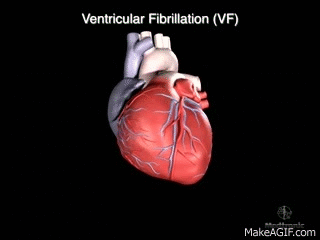


VENTRICULAR FIBRILLATION or VFIB
Ventricular fibrillation is a serious cardiac disturbance that causes abnormal heart rhythms. It can be fatal. For many people with this condition, irregular heart rhythms are the first and only sign of coronary artery disease. Ventricular fibrillation (VFib) may be confused with atrial fibrillation (AFib). Both involve irregular heart rhythms, but they affect different parts of the heart. AFib can also signal a serious heart condition, but it is typically a symptom of a chronic problem, not a life-threatening feature in itself. Treatment In emergency treatment, focus is on restoring blood flow as quickly as possible to the organs, including the brain. The patient may also receive treatment to minimize the risk of a recurrence. Emergency treatments may include cardiopulmonary resuscitation (CPR) and use of a defibrillator. Cardiopulmonary resuscitation (CPR) Early CPR and early use of an AED can may a life. Cardiopulmonary resuscitation (CPR) aims to restore blood flow through the body. Anybody with some basic life support training can do it. In the past, CPR involved cycles of 30 chest compressions to the heart, and then two mouth-to-mouth resuscitation breaths. Guidelines issued by the American Heart Association (AHA) in 2008 suggest that breathing into a person’s mouth may be unnecessary. Instead, the responder should deliver about two compressions per second, or between 100 and 120 per minute. The chest should be allowed to rise back between compressions. Once they have started, they should continue until either emergency personnel arrive or somebody comes with a portable defibrillator. Early CPR and the use of a defibrillator increases the person’s chance of survival. Using a defibrillator A defibrillator can be used together with CPR. The device sends electric shocks across the patient’s chest. The aim is to shock the heart back into normal activity. The shock may initially stop the heartbeat, but it can also stop chaotic rhythms and restore normal function. A public-use defibrillator can be used by a layperson. These devices often have voice instructions on their use. A public-use defibrillator is programmed to detect ventricular fibrillation and emit a shock at the right moment. In many countries, public-use, portable defibrillators are available in public places, such as airports, major train and bus stations, shopping malls, community centers, places where elderly people gather, casinos, and so on. Causes When the human heart beats, electrical impulses that trigger a contraction need to follow a specific route to the heart. If there is something wrong with the path of these impulses, arrhythmia, or irregular heartbeat, may occur. When the muscles in the four chambers of the heart tighten, a heartbeat occurs. During a heartbeat, a chamber closes and pushes blood out. During a heartbeat, the muscular atria, or smaller upper chambers, contract and fill the relaxed ventricles with blood. The contraction begins when the sinus node, a small group of cells in the right atrium, emits an electrical impulse which makes the right and left atria contract. The electrical impulse continues to the center of the heart, to the atrioventricular node. This node is located on the pathway between the atria and the ventricles. From the atrioventricular node, the impulse travels through the ventricles, making them contract. As a result, blood is pumped out of the heart and into the body. Symptoms The most common signs of ventricular fibrillation are sudden collapse or fainting, because the muscles and brain have stopped receiving blood from the heart. About an hour before ventricular fibrillation, some people experience: dizziness nausea pain in the chest tachycardia, or accelerated heartbeat, and palpitations
Source: https://images.app.goo.gl/fL3DadjAurJc3bhcA
